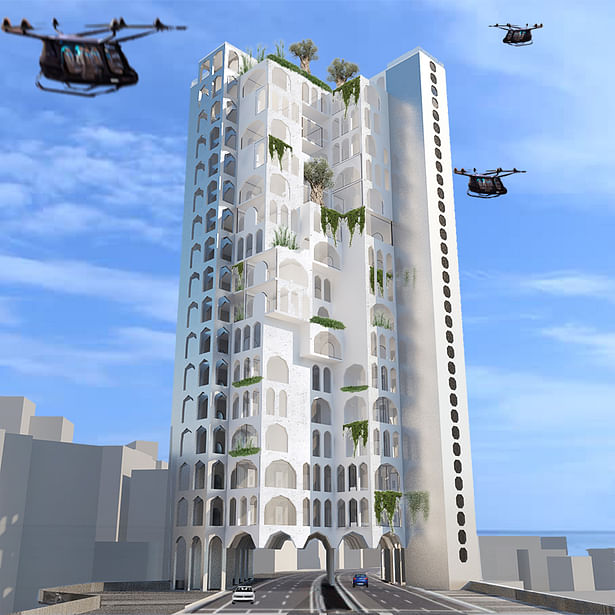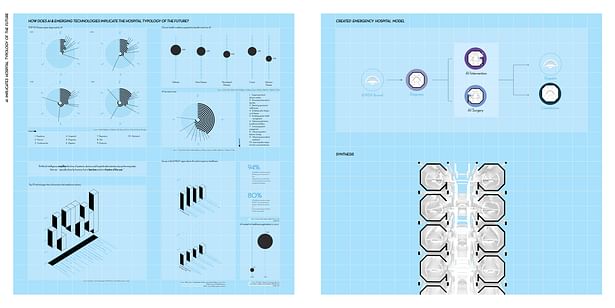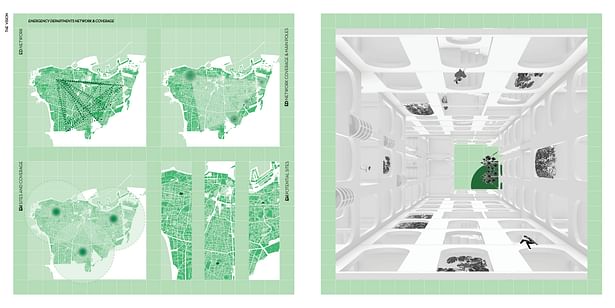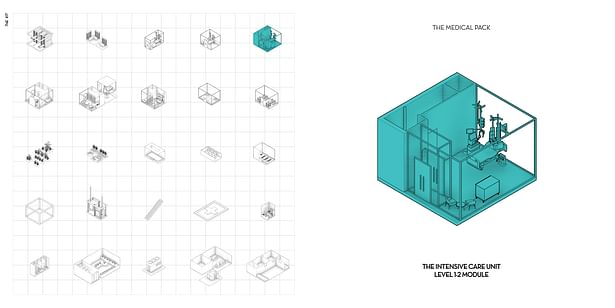
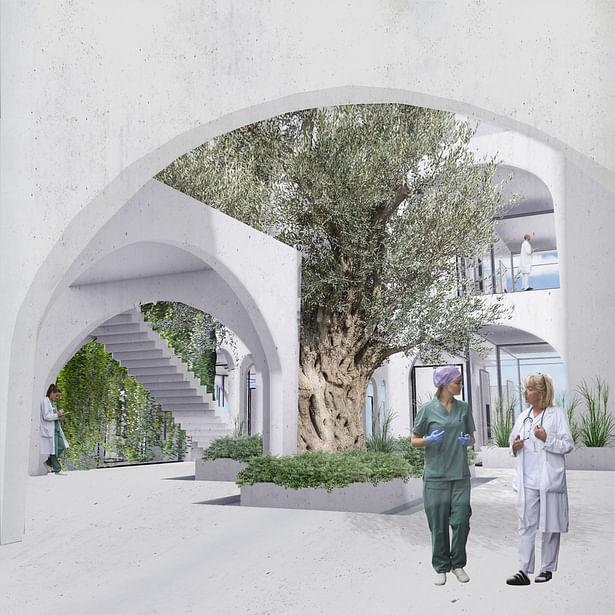
What is the hospital of the future and how can it be plugged into a dense, polluted, third world city; Beirut?
The topic:
Over the ages the human race has faced illness, pandemics, wars, injuries… and at each period of history there has been a form of healthcare institution to accommodate the people in need. This project’s main interest is oriented towards hospitals, and what could the future of the hospital be. Looking at the different typologies of “hospitals” throughout history and studying their relation, chronology and differences while studying in parallel the timeline of medical discoveries, a pattern can be discerned: Every time a medical breakthrough happens a change of typology follows. The main problem of the healthcare typology is that every time a hospital designed for a certain technology is built, it is already outdated due to a new discovery. Therefore, the hospital of the future, or may I say the future of the hospital has to be based on transformability, adaptability, structure and infrastructure in order to be able to adapt and adopt to the emerging discoveries that will once again impose new requirements; a flexible and fast-pace typology that will be able to keep up with the discovery field. In order to have a critical approach to the question the intent is to look at emerging technologies that will drastically affect the medical field, the one which has already started and will have a huge effect on medicine is Artificial Intelligence (AI).
The position and approach:
[HC[1] + AI[2]] Projecting 50 years onwards AI will not only be a crucial component in the way people are diagnosed, treated, intervened on and healed, but also on the architecture typology and the spatial needs of the healthcare institution. Having more than 50% of the world population dying each year due to emergencies (John Hopkins medicine), and a lot more during periods of war, revolution, movements, epidemics, pandemics, fire, mass shootings… emergency medicine is crucial to allow the population to overcome these occurrences. Therefore, the challenge will be creating the typology of an emergency hospital. Following up the patient “post-emergency” is as important, if not more, as the actual intervention, since approximately 10% of patient dispatched will be back in the emergency department within three days.
[HC + DE[3]] Consequently, a wellness and holistic recovery component will be added in order complete the full cycle of the patient’s health, the Emergency Hospital must not only be able to intervene on patient’s treatment time in the fastest way possible but also to make sure they are staying healthy and following their needs and prescriptions after that. The future of the hospital will then be the combination of an AI (artificial intelligence) activated emergency intervention module and a wellness and recovery module, therefore breaking away from the strict hospital typology and reimagining it in order to be more efficient and more humane. The mix of these two antipodes will also be a catalyzer in changing the aspect and the feeling generated by going to the Emergencies by creating a peaceful Eden which is only fueled by the will to heal.
What is the impact of advances in healthcare technology on hospital typologies with reference to an urban dense environment?
The design strategies:
[AI + DE] A critical design exploration and speculation to the question would be that of tackling contemporary problems with near-future technologies towards emergencies in a crowded city. Our generation is facing today the first of many forthcoming pandemics, which is the Corona virus outbreak, with until today more than six million infected and 373,000 deaths. Therefore, it is not only critical but also imperative to start incorporating, on a very elaborate scale, designs based on individualism. This, consequently, ensures the necessity of the no-human contact AI pods; medical kits that cater for pandemic crises. Plugging in the healthcare infrastructure to the existing transport infrastructure and re-imagining and reconstructing it in networks that will focus on the complementarity and the duality of the two systems coming together: Healthcare and Transportation; thus the project: The Healing Garage. To start designing this Healing Garage it is important to rely on speculative design ideologies and modes, and architecture schools of thinking such as Achigram and the Metabolist architecture, which when coupled up will form the Mechanistic part of the intervention. The problematic also comprises the systematic approach, which deals with the fields of systems, high-technology resources and biology.
[HC + AI + DE] Conceiving the building in the bases of infrastructure, high-tech movement and modules (Metabolist) introduces the concept of rationalizing the design vision; while the mechanistic approach helps find design solutions to the project, which when combined will define the strategy. These strategies are applied into a specific location – The Charles Helou Bus Station- while being concurrently revised, readjusted, and readapted to a new era; 2070. Therefore, the formulated design approach needed to conceive the healing garage consists of plugging in the city infrastructure within the composed building and Plug in (Archigram) a modular infrastructure (Metabolist) based on a systematic approach (Beaubourg), while simultaneously superimposing it on a transportation node which gives way to deconstructing and reconstructing the problematic intersection.
The design experimentations:
The Healing Garage is presented as a kit; an instrument which consists of the union between an artificial intelligence (AI) module and a Recovery module both plugged into a framed structure. By 2070 approximately 70% of the world’s population will be living in cities (UN DESA), therefore, this design is transformable, as it can be assembled in different ways in order to accommodate to different potential sites. The site best equipped to host such an emergency hospital depends on the crucial aspects of accessibility, fluidity and location. Thus, the potential sites had narrowed down to The Charles Helou Train Station. This site, which acts as both an infrastructure and a parking, is in fact located on the main artery that allows for the circulation towards and from the capital city of Beirut to occur. The kit is specifically placed on the node of the Charles Helou Bridge, which is the element within the artery that permits the access towards the city. The assembling of the kit in this location followed a specific biological methodology towards architecture. In fact, the building anatomy has the same essence as that of the human anatomy. Similar to how the human physiognomy is formed by the union of its infrastructure: bones, its system: nerves, and its structure: muscles, so does the building physiognomy, through the amalgamation of its infrastructure: the grid, its system: AI pods, and its structure: recovery modules. Thus, there exists a particular relationship between the human body and the Healing Garage.
The challenge, however, is to discover a method that allows two independent infrastructures to exist within the same baseline; the health and transportation infrastructure. The two latter subjects, which typically do not intersect, are challenged in this project in order not only to coincide but to feed upon each other as well. The clashing between the two infrastructures generates a Surrealist megastructure that plugs into the city at a very critical intersection point. The city’s high density, along with the overcrowded highway, gives way to the creation of the Urban Jungle typology, which does not rebel against the zone’s existing conditions, but rather finds ways to not only coexist with the latter but to more importantly interact with them. The infrastructure then merges into the underlying existing parking and ramp, reorienting and recreating the circulation at that intersection; thus creating a buffer zone. The healing garage creates yet another connection to the city through the networks created to repatriate and dispatch EMSVs[4], which operate within underground pipes, through drones and through the sea. In this sense the building relates and adapts to the city, without losing its essence and complexity. In fact, at the critical moments of intersection between the building and the city, the Healing Garage portrays the epitome moments of horizontal and vertical absurdities.
Since the healing garage is presented as a kit, a user manual was created in order to convey information about the elements that form the kit, the steps to follow in order to implement it in a city, and a simulation explaining how to potentially assemble it. The kit consists of 3 different packs, the medical pack, the healing pack and the serving pack.
[1] Healthcare
[2] Artificial Intelligence
[3] Dense Environment
[4] Emergency medicine service vehicle
Status: School Project
Location: Beirut, LB
Additional Credits: American University of Beirut
